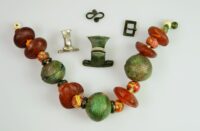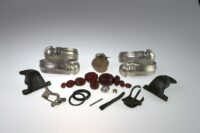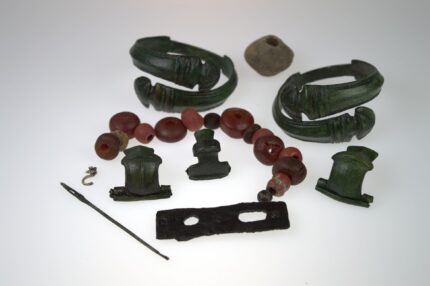 A recent study of jewelry and other artifacts manufactured by the Goths in what is now Poland has found metal work of such high quality that it is comparable to Roman objects from that period. Archaeologist Dr. Magdalena Natuniewicz-Sekuła from the Institute of Archeology and Ethnology of the Polish Academy of Sciences in Warsaw studied a large group of metal objects unearthed from an ancient cemetery in the village of Weklice, northern Poland. More than 3,500 artifacts have been discovered in 600 burials of East Germanic Goth and Gepid people dating from the 1st through 4th century A.D.
A recent study of jewelry and other artifacts manufactured by the Goths in what is now Poland has found metal work of such high quality that it is comparable to Roman objects from that period. Archaeologist Dr. Magdalena Natuniewicz-Sekuła from the Institute of Archeology and Ethnology of the Polish Academy of Sciences in Warsaw studied a large group of metal objects unearthed from an ancient cemetery in the village of Weklice, northern Poland. More than 3,500 artifacts have been discovered in 600 burials of East Germanic Goth and Gepid people dating from the 1st through 4th century A.D.
 Analysis of a selection of these grave goods revealed that the silver was of very high purity, exceeding modern standards for jewelry. Sterling silver ornaments today contain 92.5% silver (that’s what the 925 fineness designation means). The pieces from the Weklice examined by Natuniewicz-Sekuła are much higher in silver content, reaching 970-990. The gold objects analyzed were equally high in gold content.
Analysis of a selection of these grave goods revealed that the silver was of very high purity, exceeding modern standards for jewelry. Sterling silver ornaments today contain 92.5% silver (that’s what the 925 fineness designation means). The pieces from the Weklice examined by Natuniewicz-Sekuła are much higher in silver content, reaching 970-990. The gold objects analyzed were equally high in gold content.
 Pure silver and gold are very malleable and hard to manipulate, which is why it’s necessary to add other metals to make an alloy that can take complex designs. The Weklice objects employed specialized, difficult techniques including fire gilding, granulation and filigree. Alloys of such high purity would never be used to create objects with these techniques today, not because it’s impossible but because it’s so difficult and time-consuming that it would be cost-prohibitive.
Pure silver and gold are very malleable and hard to manipulate, which is why it’s necessary to add other metals to make an alloy that can take complex designs. The Weklice objects employed specialized, difficult techniques including fire gilding, granulation and filigree. Alloys of such high purity would never be used to create objects with these techniques today, not because it’s impossible but because it’s so difficult and time-consuming that it would be cost-prohibitive.
No full sets of the equipment necessary to refine the metals used have ever been found, leading archaeologists to speculate that bullion bars were brought to the area from the Roman Empire, despite a strict ban.
If bullion was unavailable to the metalsmiths, it is also possible that they refined the silver and other metals from coins and other items.
Dr Natuniewicz-Sekuła said: “We cannot rule out that the Goths knew the methods of refining and cupellation (the separation of noble metals from base ones under high temperature).
“In this way, they may have been able to ‘purify’ the silver obtained from coins, but this is only a guess.”
Coin silver was fairly low in purity, averaging around 800-850, so if that was their source they had to be very adept indeed at refining the precious metal.

They certainly were adept to fine metalwork. However, those reddish beads with the yellow stripes look like glass, while the bigger ones might to be amber.
The La Tène period ‘Wallertheim puppy’, a.k.a ‘glass dog from Wallertheim’ is not unequal to glass goods from Egypt, and trade networks are sometimes older than expected.
The Late Bronze Age Uluburun Shipwreck (14th century BC) in what is now Turkey had likewise amber beads of Baltic origin and glass goods aboard.